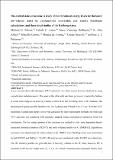Files in this item
The excited states of azulene : a study of the vibrational energy levels for the lower ππ*-valence states by configuration interaction and density functional calculations, and theoretical studies of the Rydberg states
Item metadata
| dc.contributor.author | Palmer, Michael H | |
| dc.contributor.author | Jones, Nykola C | |
| dc.contributor.author | Hoffmann, Soren V | |
| dc.contributor.author | Aitken, R Alan | |
| dc.contributor.author | Coreno, Marcello | |
| dc.contributor.author | de Simone, Monica | |
| dc.contributor.author | Grazioli, Cesare | |
| dc.contributor.author | Patterson, Iain | |
| dc.date.accessioned | 2022-11-09T11:30:30Z | |
| dc.date.available | 2022-11-09T11:30:30Z | |
| dc.date.issued | 2022-10-20 | |
| dc.identifier | 281382292 | |
| dc.identifier | 3fd9bc46-831c-491c-acba-ebd259c8ddbb | |
| dc.identifier | 85140347106 | |
| dc.identifier | 000875621100010 | |
| dc.identifier.citation | Palmer , M H , Jones , N C , Hoffmann , S V , Aitken , R A , Coreno , M , de Simone , M , Grazioli , C & Patterson , I 2022 , ' The excited states of azulene : a study of the vibrational energy levels for the lower ππ*-valence states by configuration interaction and density functional calculations, and theoretical studies of the Rydberg states ' , The Journal of Chemical Physics , vol. 157 , no. 15 , 154307 . https://doi.org/10.1063/5.0106697 | en |
| dc.identifier.issn | 0021-9606 | |
| dc.identifier.other | ORCID: /0000-0001-6959-5311/work/121312366 | |
| dc.identifier.uri | https://hdl.handle.net/10023/26341 | |
| dc.description.abstract | A new vacuum ultraviolet absorption spectrum of azulene vapour has been obtained by using a synchrotron radiation source.The onset of the ultraviolet spectrum, previously reported by Sidman et al has been analysed in detail by Franck-Condon (FC) and Herzberg-Teller (HT) methods. The PES profile identifies the 3px-Rydberg state 00 band as 131 cm-1 from the VUV maximum. Excited state energy levels were calculated by three independent methods: the wide scan VUV spectrum was correlated with symmetry adapted cluster configuration interaction (SAC-CI) calculations. The low energy portion of the spectrum was studied by both time dependent density functional theoretical methods (TDDFT) and multi-reference multi-root CI (MRD-CI). Equilibrium structures were determined for valence states at the TDDFT level. Rydberg states were determined by both TDDFT and MRD-CI. The FC+HT analyses were performed on the TDDFT wave-functions. The HT intensity profile is generally low in intensity, relative to the FC ones; however, HT is dominant in the second singlet state (S2, 11A1). As a result, numerous non-symmetric modes, their overtones and combination bands show considerable intensity in that band. Extremely diffuse s-, p-, d- or f-character functions enabled extrapolation to the IE1 for many Rydberg states (RS). The lowest RS based on IE2 (3b13s) lies at 4.804 eV with quantum defect 0.714. Differentiation between valence and RS is readily made using the second moments of the charge distribution. | |
| dc.format.extent | 15 | |
| dc.format.extent | 8634008 | |
| dc.language.iso | eng | |
| dc.relation.ispartof | The Journal of Chemical Physics | en |
| dc.subject | QC Physics | en |
| dc.subject | QD Chemistry | en |
| dc.subject | NDAS | en |
| dc.subject | MCC | en |
| dc.subject.lcc | QC | en |
| dc.subject.lcc | QD | en |
| dc.title | The excited states of azulene : a study of the vibrational energy levels for the lower ππ*-valence states by configuration interaction and density functional calculations, and theoretical studies of the Rydberg states | en |
| dc.type | Journal article | en |
| dc.contributor.institution | University of St Andrews. School of Chemistry | en |
| dc.contributor.institution | University of St Andrews. EaSTCHEM | en |
| dc.identifier.doi | https://doi.org/10.1063/5.0106697 | |
| dc.description.status | Peer reviewed | en |
| dc.date.embargoedUntil | 2022-10-20 |
This item appears in the following Collection(s)
Items in the St Andrews Research Repository are protected by copyright, with all rights reserved, unless otherwise indicated.

